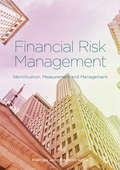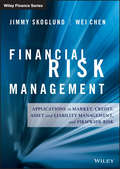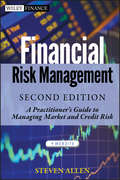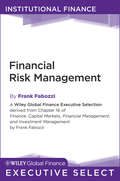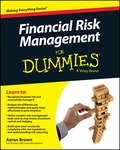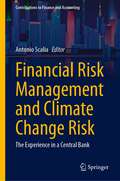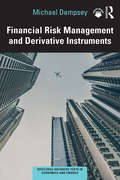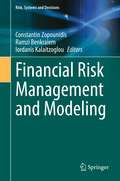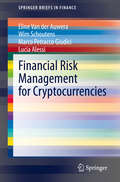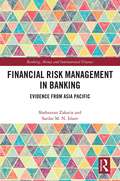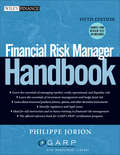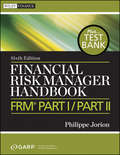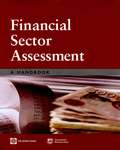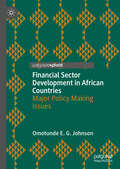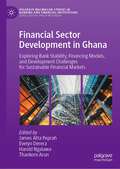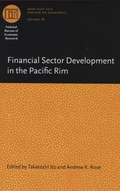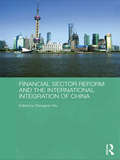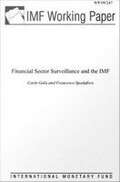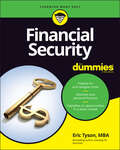- Table View
- List View
Financial Risk Management
by Francisco Javier Población GarcíaThis book provides a quantitative overview of corporate risk management for both financial and non-financial organisations. It systematically explores a range of important risks, including interest rate risk, equity risk, commodity price risk, credit risk management, counterparty risk, operational risk, liquidity risk, market risk, derivative credit risk and country risk. Chapters also provide comprehensive and accessible analysis of risk-related phenomena and the corporate strategies employed to minimise the impacts of risk in each case. Chapters begin with an explanation of basic concepts and terminology, before going on to present quantitative examples and qualitative discussion sections. The author leverages his lifetime’s experience of working in risk management to offer this clear and empirical guide for scholars and practitioners researching financial stability.
Financial Risk Management
by Wei Chen Jimmy SkoglundA global banking risk management guide geared toward the practitioner Financial Risk Management presents an in-depth look at banking risk on a global scale, including comprehensive examination of the U. S. Comprehensive Capital Analysis and Review, and the European Banking Authority stress tests. Written by the leaders of global banking risk products and management at SAS, this book provides the most up-to-date information and expert insight into real risk management. The discussion begins with an overview of methods for computing and managing a variety of risk, then moves into a review of the economic foundation of modern risk management and the growing importance of model risk management. Market risk, portfolio credit risk, counterparty credit risk, liquidity risk, profitability analysis, stress testing, and others are dissected and examined, arming you with the strategies you need to construct a robust risk management system. The book takes readers through a journey from basic market risk analysis to major recent advances in all financial risk disciplines seen in the banking industry. The quantitative methodologies are developed with ample business case discussions and examples illustrating how they are used in practice. Chapters devoted to firmwide risk and stress testing cross reference the different methodologies developed for the specific risk areas and explain how they work together at firmwide level. Since risk regulations have driven a lot of the recent practices, the book also relates to the current global regulations in the financial risk areas. Risk management is one of the fastest growing segments of the banking industry, fueled by banks' fundamental intermediary role in the global economy and the industry's profit-driven increase in risk-seeking behavior. This book is the product of the authors' experience in developing and implementing risk analytics in banks around the globe, giving you a comprehensive, quantitative-oriented risk management guide specifically for the practitioner. Compute and manage market, credit, asset, and liability risk Perform macroeconomic stress testing and act on the results Get up to date on regulatory practices and model risk management Examine the structure and construction of financial risk systems Delve into funds transfer pricing, profitability analysis, and more Quantitative capability is increasing with lightning speed, both methodologically and technologically. Risk professionals must keep pace with the changes, and exploit every tool at their disposal. Financial Risk Management is the practitioner's guide to anticipating, mitigating, and preventing risk in the modern banking industry.
Financial Risk Management
by Steven AllenA top risk management practitioner addresses the essential aspects of modern financial risk management In the Second Edition of Financial Risk Management + Website, market risk expert Steve Allen offers an insider's view of this discipline and covers the strategies, principles, and measurement techniques necessary to manage and measure financial risk. Fully revised to reflect today's dynamic environment and the lessons to be learned from the 2008 global financial crisis, this reliable resource provides a comprehensive overview of the entire field of risk management. Allen explores real-world issues such as proper mark-to-market valuation of trading positions and determination of needed reserves against valuation uncertainty, the structuring of limits to control risk taking, and a review of mathematical models and how they can contribute to risk control. Along the way, he shares valuable lessons that will help to develop an intuitive feel for market risk measurement and reporting. Presents key insights on how risks can be isolated, quantified, and managed from a top risk management practitioner Offers up-to-date examples of managing market and credit risk Provides an overview and comparison of the various derivative instruments and their use in risk hedging Companion Website contains supplementary materials that allow you to continue to learn in a hands-on fashion long after closing the book Focusing on the management of those risks that can be successfully quantified, the Second Edition of Financial Risk Management + Websiteis the definitive source for managing market and credit risk.
Financial Risk Management (Wiley Global Finance Executive Select #178)
by Frank J. FabozziCreated by the experienced author team of Frank Fabozzi and Pamela Peterson Drake, Financial Risk Management examines the essential elements of this discipline and makes them accessible to a wide array of readers-from seasoned veterans looking for a review to newcomers needing to get their footing in finance. Financial risk is the exposure of a corporation to an event that can cause a shortfall in a targeted financial measure or value and includes market risk, credit risk, market liquidity risk, operational risk, and legal risk. This material discusses the four key processes in financial risk management: risk identification, risk assessment, risk mitigation, and risk transferring. The process of risk management involves determining which risks to accept, which to neutralize, and which to transfer.
Financial Risk Management For Dummies
by Aaron BrownTake the risk out of financial risk management Written by bestselling author and past winner of the GARP Award's Risk Manager of the Year, Aaron Brown, Financial Risk Management For Dummies offers thorough and accessible guidance on successfully managing and controlling financial risk within your company. Through easy-to-follow instruction, you'll find out how to manage risk, firstly by understanding it, and then by taking control of it. Plus, you'll discover how to measure and value financial risk, set limits, stop losses, control drawdowns and hedge bets. Financial risk management uses financial instruments to manage exposure to risk within firms, large and small—particularly credit risk and market risk. From managing and measuring risk to working in financial institutions and knowing how to communicate risk to your company and clients, Financial Risk Management For Dummies makes it easy to make sense of the management of risk when working in various different financial institutions and concludes by covering the topic of how to communicate risk — how to report it properly and how to deal with and comply with all of the regulations. Covers managing risk and working as a financial risk manager Provides everything you need to know about measuring financial risk Walks you through working in financial institutions Demonstrates how to communicate risk If you work in the financial sector and want to make financial risk management your mission, you've come to the right place!
Financial Risk Management and Climate Change Risk: The Experience in a Central Bank (Contributions to Finance and Accounting)
by Antonio ScaliaFinancial risk management for institutional investors has recently grown in scope to include long-term sustainability considerations and climate change risk concerns. This book shows how a national central bank in the Eurosystem has adapted its financial risk management principles and practices against the background of non-conventional monetary policy measures and following the introduction of sustainability criteria, with a special role for carbon-neutrality. The topics covered include a market-based approach to evaluating credit risk, the development of an independent credit rating system, and the properties and limitations of agencies’ sovereign ratings. Furthermore, the book analyzes the integration of sustainability principles into strategic asset allocation and describes the use of machine learning techniques for discerning the role of the E, S and G variables in equity returns. The authors also discuss the growth of the global green bond market and the greenium, as well as the sustainability indicators for large portfolios of corporate and government securities. Given its scope, the book will appeal to all professionals working in the field who would like to know the state-of-the-art in these areas.
Financial Risk Management and Derivative Instruments (Routledge Advanced Texts in Economics and Finance)
by Michael DempseyFinancial Risk Management and Derivative Instruments offers an introduction to the riskiness of stock markets and the application of derivative instruments in managing exposure to such risk. Structured in two parts, the first part offers an introduction to stock market and bond market risk as encountered by investors seeking investment growth. The second part of the text introduces the financial derivative instruments that provide for either a reduced exposure (hedging) or an increased exposure (speculation) to market risk. The fundamental aspects of the futures and options derivative markets and the tools of the Black-Scholes model are examined. The text sets the topics in their global context, referencing financial shocks such as Brexit and the Covid-19 pandemic. An accessible writing style is supported by pedagogical features such as key insights boxes, progressive illustrative examples and end-of-chapter tutorials. The book is supplemented by PowerPoint slides designed to assist presentation of the text material as well as providing a coherent summary of the lectures. This textbook provides an ideal text for introductory courses to derivative instruments and financial risk management for either undergraduate, masters or MBA students.
Financial Risk Management and Modeling (Risk, Systems and Decisions)
by Constantin Zopounidis Ramzi Benkraiem Iordanis KalaitzoglouRisk is the main source of uncertainty for investors, debtholders, corporate managers and other stakeholders. For all these actors, it is vital to focus on identifying and managing risk before making decisions. The success of their businesses depends on the relevance of their decisions and consequently, on their ability to manage and deal with the different types of risk. Accordingly, the main objective of this book is to promote scientific research in the different areas of risk management, aiming at being transversal and dealing with different aspects of risk management related to corporate finance as well as market finance. Thus, this book should provide useful insights for academics as well as professionals to better understand and assess the different types of risk.
Financial Risk Management for Cryptocurrencies (SpringerBriefs in Finance)
by Wim Schoutens Lucia Alessi Eline Van der Auwera Marco Petracco GiudiciThis book explores the emerging field of risk management and risk analysis of cryptocurrencies, an area that has been generating considerable research. It begins by providing an introduction to digital finance and the concept of cryptocurrencies and blockchain technologies. It then describes in detail the intrinsic risks involved in cryptocurrencies, an area that, to date, has not been fully documented or investigated. Lastly, it discusses the various types of risk, with a focus on design, operational, market and quantitative risks.Providing insights into the analysis and management of cryptocurrencies, and serving as a starting point for a more in-depth risk analysis, this book will appeal to professionals and researchers interested in familiarizing themselves with the risks in cryptocurrencies, including academics, portfolio managers, risk-managers, quants, financial professionals, regulators, economists, asset managers and traders.
Financial Risk Management in Banking: Evidence from Asia Pacific (Banking, Money and International Finance #17)
by Shahsuzan Zakaria Sardar IslamAs risk-taking is an essential part of the banking industry, banks must practise efficient risk management to ensure survival in uncertain financial climates. Banking operations are specifically affected by fluctuations in interest rates which cause financial imbalance; thus banks are now required to put in place an effective management structure that incorporates risk management efficiency measures that help mitigate the wide range of risks they face. In this book, the authors have developed a new modelling approach to determine banks’ financial risk management by offering detailed insights into the integrated approach of dollar-offset ratio and Data Envelopment Analysis (DEA), based on derivatives usage. It further analyses the efficiency measurement under stochastic DEA approaches, namely (i) Bootstrap DEA (BDEA), (ii) Sensitivity Analysis and (iii) Chance-Constrained DEA (CCDEA). As demonstrated in the modelling exercise, this integrated approach can be applied to other cases that require risk management efficiency measurement strategies. Additionally, this is the first book to comprehensively review the derivative markets of both the developed and developing countries in the Asia-Pacific region, by examining the differences of risk management efficiency of the banking institutions in these countries. Based on this measurement approach, strategies are provided for banks to improve their strategic risk management practices, as well as to reduce the impacts from external risks, such as changes in interest rates and exchange rates. Furthermore, this book will help banks to keep abreast of recent developments in the field of efficiency studies in management accounting, specifically in relation to hedge accounting, used by banks in the Asia-Pacific region.
Financial Risk Manager Handbook 5th Edition with CD
by Philippe Null JorionThe essential reference for financial risk management Filled with in-depth insights and practical advice, the Financial Risk Manager Handbook is the core text for risk management training programs worldwide. Presented in a clear and consistent fashion, this completely updated Fifth Edition-which comes with an interactive CD-ROM containing hundreds of multiple-choice questions from previous FRM exams-is one of the best ways to prepare for the Financial Risk Manager (FRM) exam. Financial Risk Manager Handbook, Fifth Edition supports candidates studying for the Global Association of Risk Professional's (GARP) annual FRM exam and prepares you to assess and control risk in today's rapidly changing financial world. Authored by renowned risk management expert Philippe Jorion-with the full support of GARP-this definitive guide summarizes the core body of knowledge for financial risk managers. Offers valuable insights on managing market, credit, operational, and liquidity risk Examines the importance of structured products, futures, options, and other derivative instruments Identifies regulatory and legal issues Addresses investment management and hedge fund risk Financial Risk Manager Handbook is the most comprehensive guide on this subject, and will help you stay current on best practices in this evolving field. The FRM Handbook is the official reference book for GARP's FRM® certification program. Note: CD-ROM/DVD and other supplementary materials are not included as part of eBook file.
Financial Risk Manager Handbook: FRM Part I / Part II (Wiley Finance #625)
by Philippe Jorion GARP (Global Association of Risk Professionals)The essential reference for financial risk management Filled with in-depth insights and practical advice, the Financial Risk Manager Handbook is the core text for risk management training programs worldwide. Presented in a clear and consistent fashion, this completely updated Sixth Edition, mirrors recent updates to the new two-level Financial Risk Manager (FRM) exam, and is fully supported by GARP as the trusted way to prepare for the rigorous and renowned FRM certification. This valuable new edition includes an exclusive collection of interactive multiple-choice questions from recent FRM exams. Financial Risk Manager Handbook, Sixth Edition supports candidates studying for the Global Association of Risk Professional's (GARP) annual FRM exam and prepares you to assess and control risk in today's rapidly changing financial world. Authored by renowned risk management expert Philippe Jorion, with the full support of GARP, this definitive guide summarizes the core body of knowledge for financial risk managers. Offers valuable insights on managing market, credit, operational, and liquidity risk Examines the importance of structured products, futures, options, and other derivative instruments Contains new material on extreme value theory, techniques in operational risk management, and corporate risk management Financial Risk Manager Handbook is the most comprehensive guide on this subject, and will help you stay current on best practices in this evolving field. The FRM Handbook is the official reference book for GARP's FRM certification program.
Financial Risks, Stability, and Globalization
by Omotunde E.G JohnsonThis book contains the proceedings of the IMF's eighth Central Banking Seminar held in the US in June 2000. These seminars have been organised every two to three years to provide a discussion forum for IMF members, and this publication focuses on the stability of the international financial institutions and risk management issues.
Financial Sector Assessment
by International Monetary FundA report from the International Monetary Fund.
Financial Sector Assessment Program
by International Monetary FundA report from the International Monetary Fund.
Financial Sector Crisis and Restructuring Lessons from Asia
by Charles Enoch Carl Johan Lindgren Leslie TeoA report from the International Monetary Fund.
Financial Sector Development in African Countries: Major Policy Making Issues
by Omotunde E. JohnsonThis Palgrave Pivot begins with a broad focus on financial sector development as a whole, highlighting areas such as the money market, payment system, and the capital market, as well as issues such as regulatory strategy, capacity building of financial firms and service providers, and financial inclusion. In the area of foreign exchange market policies, the book argues that African countries should aim for social efficiency of the markets, which would include soundness of their foreign exchange systems, from an economic growth perspective, and fairness from an income distributional perspective. Finally, in recognition of the fact that some African countries desire financial systems that are strong enough to be international centers of finance, the policy-making implications of that ambition are discussed. This book will be of interest to scholars and students in development economics, finance, and money and banking, as well as policy-makers and practitioners. Further, international organisations and independent research organisations interested in economic development in general or financial system development issues will also find this book of value.
Financial Sector Development in Ghana: Exploring Bank Stability, Financing Models, and Development Challenges for Sustainable Financial Markets (Palgrave Macmillan Studies in Banking and Financial Institutions)
by Thankom Arun James Atta Peprah Evelyn Derera Harold NgalawaThis book investigates factors that contribute to the development of an efficient financial sector in Ghana. While sustainable finance has long been known to propel economic growth and development, and while many African countries have taken initiatives to develop integrated frameworks of their financial sectors that tackle developmental challenges, scholars and policymakers have always grappled with understanding of factors that enhance performance of the financial sector. In this book, an expert team of authors examines the financial landscape, central bank policies, competition, financial innovation, financial inclusion and banking stability in Ghana, while also exploring how financing models such as enterprise finance and microfinance can be more effective in sustaining financial markets. The authors discuss how Ghana can build fortified institutions, regulatory frameworks, and productive capacity to strengthen the financial sector and foster pathways that will enhance economic development. Empirical and scientific evidence give this book a unique approach that is both qualitative and quantitative.
Financial Sector Development in Sub-Saharan African Countries
by George Iden Peter C. Hayward Jean-Pierre BriffautA report from the International Monetary Fund.
Financial Sector Development in the Pacific Rim
by Takatoshi Ito Andrew RoseThe reform in Asian financial sectors-- especially in banking and stock markets-- has been remarkable since the currency crisis of 1997-98. East Asia is now a major player in international finance, providing serious competition to the more traditional financial centers of London and New York. Financial Sector Development in the Pacific Rim provides a rich collection of theoretical and empirical analyses of the growing capital markets in the region. Bringing together authors from various East Asian and Pacific nations, this volume examines the institutional factors influencing financial innovation, the consequences of financial development, widespread consolidation occurring through mergers and acquisitions, and the implementation of policy reform. Financial Sector Development in the Pacific Rim offers the comparative analysis necessary to answer broad questions about economic development and the future of Asia.
Financial Sector Reform and the International Integration of China (Routledge Studies on the Chinese Economy)
by Zhongmin WuChina's economy, which continues to grow rapidly, is having an ever greater impact on the rest of the world. This impact is likely to be felt increasingly in the financial sector where China's foreign currency reserves, fuelled by the huge trade surplus, are a very significant factor in world financial markets. This book, based on extensive original research by a range of leading experts, examines many key aspects of current reforms in China's financial sector and China's increasing integration into the international economy. Subjects covered amongst many others include: the derivatives market in China; stock market liberalisation; the internationalization of accounting standards in China; the impact of international foreign direct investment by Chinese firms; and a discussion of the likely long-term economic effects of the Beijing Olympic Games.
Financial Sector Reforms and Exchange Arrangements in Eastern Europe
by Paul R. Masson Eduardo Borensztein Guillermo CalvoA report from the International Monetary Fund.
Financial Sector Surveillance and the IMF
by Carlo Gola Francesco SpadaforaA report from the International Monetary Fund.
Financial Security For Dummies
by Eric TysonBoost your financial health so you’re ready for any economic or personal upheaval Crisis is inevitable—but it doesn’t have to torpedo your finances! Financial Security For Dummies offers proven advice to help you prep your finances for the next economic downturn, personal setback, pandemic, plague of locusts—or anything else life throws your way. This book contains the historical perspective and up-to-date info you’ll need to anticipate, understand, and navigate a wide range of personal financial challenges. If your monthly income and expenses are on steady ground and you’re ready to secure your financial future, this is the For Dummies guide for you. Not only will you create a plan to keep your family’s finances afloat during turbulent times, but you’ll also be liberated from the pressure to “keep up with the Joneses” so you can make smarter financial decisions, starting today. This book will help you: Gain an understanding of how unforeseen personal or global events could affect your financial life Learn strategies for protecting your assets when economic downturns and other emergencies occur Feel confident in your unique path to financial freedom so you can remain calm when life takes an unexpected turn Build a survival plan for protecting yourself with broader safety nets, better money decisions, and improved financial literacy Whether you want to reduce your stress surrounding your financial goals or take advantage of financial opportunities crises create, Financial Security For Dummies will equip you to navigate financial challenges and ultimately achieve peace of mind.
Financial Security and Personal Wealth
by Lewis D. SolomonAmerica's elderly population is soaring, presenting numerous challenges for policymakers in the United States. Other developed nations with aging populations face similar problems. There will be fewer workers relative to retirees in coming decades and the elderly are also expected to live longer. The impact of these demographic changes in the United States is likely to be challenging, especially for America's system of social security. Solomon offers new perspectives on how to meet the future costs of social security without bankrupting the next generation or gravely damaging the U.S. economy. He also shows, more broadly, how to provide for the financial security of America's senior populations.Over the past two decades, primary responsibility for providing a financially adequate retirement has shifted from the federal government and employers to individuals. For most Americans, social security alone will not provide enough income. Most companies have shed their pension plans for 401(k) plans, to which companies and employees contribute, and in which participants must make their own investment decisions. Consequently, achieving financial security in retirement has increasingly become one's personal responsibility.Solomon deals extensively with the politics of social security, past and present. He examines the presidential leadership of Franklin D. Roosevelt and Ronald Reagan, both of whom revived the nation's spirit in times of crisis, both of whom introduced economic policies that remain controversial to the present day. He also considers in detail contemporary efforts to rethink social security, focusing on fundamental reform of the social security system and the expansion and simplification of employer-sponsored retirement plans and individual retirement arrangements.Richly textured, informed, and informative, Financial Security and Personal Wealth encompasses history, demography, political economy, public finance, social policy.
